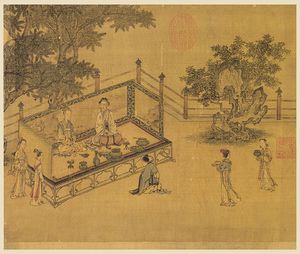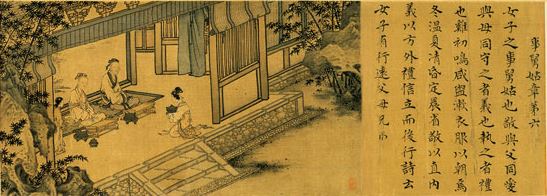تبجيل الوالدين
| عبادة الوالدين Filial piety | |||||||||||||||||
|---|---|---|---|---|---|---|---|---|---|---|---|---|---|---|---|---|---|
 منظر من الرسومات الشارحة في تقليد تبجيل الوالدين في عهد أسرة سونگ (تفاصيل)، يصور ابن يركع أمام والديه.[1] | |||||||||||||||||
| Chinese name | |||||||||||||||||
| الصينية | 孝 | ||||||||||||||||
| |||||||||||||||||
| Vietnamese name | |||||||||||||||||
| Vietnamese alphabet | hiếu | ||||||||||||||||
| Korean name | |||||||||||||||||
| Hangul | 효 | ||||||||||||||||
| Hanja | 孝 | ||||||||||||||||
| |||||||||||||||||
| Japanese name | |||||||||||||||||
| Kanji | 孝 | ||||||||||||||||
| Kana | こう | ||||||||||||||||
| |||||||||||||||||
في الفلسفة الكونفوشية، تبجيل الوالدين filial piety (الصينية: 孝, xiào)، هو فضيلة احترام الشخص لأبويه، كبار السن، والأسلاف. شياو جينگ، التقليد الكونفوشي، أو تقليد شياو، يـُعتقد أنه كـُتـِب في فترة تشين-هان تقريباً، واعتـُبـِر تاريخياً مصدراً موثـِقاً لمعيار شياو/"احترام الوالدين" الكونفوشي. الكتاب، عبارة عن مقارنة بين كونفوشيوس وتلميذه زنگ شن (曾參، وشهرته زونگزي 曾子)، يدور حول كيفية تأسيس المجتمع الصالح باستخدام مبدأ شياو (احترام الوالدين). قد يطبق المصطلح أيضاً على الطاعة العامة، ويستخدم في الألقاب الدينية في الكنائس المسيحية، مثل "القس الأبوي" أو "الكاهن الأبوي" لرجل الدين الذي تتبع كنيسته أبرشية أكبر. يتمركز الاحترام الأبوي حول دور الأخلاق الكونفوشيوسية.[2]
في مصطلحات أكثر شمولاً، يعني الاحترام الأبوي أن يحسن الشخص لوالديه؛ يعتني بوالديه؛ ينخرط في السلوك الحسن ليس فقط تجاه والديه لكنه خارج المنزل أيضاً ليجلب التسمية الاسم الجيد لوالديه وأسلافه؛ أن يؤدي واجبات عمله بشكل جيد للحصول على السبل المادية لدعم والديه وكذلك لتقديم القرابين للأسلاف؛ وألا يكون متمرداً؛ يظهر الحب، يحترم يدعم؛ يجامل؛ يضمن الورثة الذكور، يدعم الأخوة بين الأشقاء؛ ينصح بحكمة والديه، بما في ذلك إثنائهم عن ارتكاب الآثام الأخلاقية؛ يظهر الأسف عند مرضهم أو موتهم؛ يقدم القرابين بعد وفاتهم.
يعتبر احترام الوالدين الفضيلة الأساسية في الثقافة الصينية، ويشكل المحور الرئيسي لعدد كبير من القصص. من بين أشهر مجموعات هذه القصص The Twenty-four Filial Exemplars (Ershi-si xiao 二十四孝). تصف هذه القصص كيف كان الأطفال يحترمون آبائهم في الماضي. بينما دائماً ما امتلكت الصين اعتقادات دينية متنوعة، فاحترام الوالدين من أكثرها شيوعاً، وصف المؤرخ هيو د. ر. بيكر احترام العائلة بالعنصر الوحيد الشائع بين جميع المؤمنين الصينيين تقريباً.[3]
التسمية
الأهمية الثقافية
الكونفوشيوسية

حسب تقليد تبجيل الوالدين، فإن كونفوشيوس قال ذات مرة: "بخدمتك والديه، يبقى الابن البار مقدساً إياهم في الحياة اليومية؛ فيجعلهما سعداء بخدمتهما؛ ويسهر على رعايتهم حين يمرضون؛ ويُظهر جزعاً عظيماً على وفاتهما كما لو كان هو من يواجه الموت؛ وأن يضحي من أجلهما بقلب وجل."[5] فبالنسبة لكونفوشيوش، فإن تبجيل الآباء لم يكن مجرد طاعة عمياء للوالدين. فالأهم من معيار شياو xiào كان معيار رِن rén (仁؛ الخير) و يي yì (義; الإنصاف). فلكل من كونفوشيوس ومنشيوس، فإن شياو هي تجلي للـ رن والتي يتمسك بها المرء في تعامله مع كل كبار السن عموماً، وبذلك فإنهما يجعلانها معياراً عاماً للعلاقات بين الأجيال. إلا أنه في الممارسة، فعادةً ما تـُخصص شياو لتعامل المرء مع أبويه وأجداده، ومن حين لآخر، يرتقي فوق مفاهيم رن و يي.
تبجيل الآباء أكدت عليه الكونفوشية لأن تفاني المرء في تبجيل أبويه، كثيراً ما اقترن مع تفاني المرء في تبجيل الدولة.[6]
البوذية
لم يكن بالبوذية المبكرة تعاليم قوية تحث على تبجيل الوالدين. وتضمنت البوذية في الهند سيَر العديد من الأولياء الذين تركوا عائلاتهم وآبائهم وزوجاتهم وأطفالهم ليصبحوا رهباناً (بوذا نفسه قيل أنه فعل ذلك). فالبوذي الحق عليه أن يرفض كل الصلات العائلة، تماماً كما أن عليه أن يرفض كل الروابط الاجتماعية والطبقية إذا أراد أن يسعى إلى النرڤانا. فالأسرة كان يُنظر إليها كعائق آخر من الحياة الزائلة يجب التعامل معه. والحزن والحداد قيل أنهما "وُلِدا ممن هم أعزاء علينا."[7] لذا أُجبِر الرهبان البوذيون على قطع كل صلاتهم بعائلاتهم وأن ينسوا أسلافهم. وتركِز بوذية الثراودة على الخلاص الفردي، ولا مكان فيها للمجتمع المترابط الذي خلقته الكونفوشية في الصين، والذي يركز على خير المجتمع أكثر من خير الفرد. بينما في الهند، فالبوذية تدعو إلى التبتل بين الرهبان وهو أمر غير مقبول في نظر العالم الكونفوشي، إذ أن الكونفوشية ترى أن واجب الطفل أن يحفظ على تسلسل النسل.[8]
قدوم البوذية إلى الصين
حين قدمت البوذية إلى الصين، أعيد تعريفها لتدعم تبجيل الوالدين. موزي ليهوولون (牟子理惑論)، العمل الذي يدافع عن البوذية للقارئ الصيني، قدم مناقشات لرهبان بوذيين يبدو أنهم كانوا يسيئون معاملة والديهم، بقراءة متعمقة في أعمال كونفوشيوس نفسه. گوييانگتو (跪羊图، Guiyangtu)[9] و سوترا نيردسا، من ڤيمالاكرتي،[10] هي أيضاً أعمال بوذية تصوّر واجبات والتزامات رب الأسرة من العامة، مقارَناً بالتجرد التام للرهبان.
موزي ليهوولون
موزي ليهوولون يقارن راهب بوذي بإبن بار ينقذ والده من الغرق.
A long time ago, the Ch'i people crossed a large river in a boat and it happened that their father fell into the water. His sons rolled up their sleeves, seized his head, and turned him upside down, forcing the water out of his mouth, thus bringing their father back to life. Now, to seize one's father's head and turn him upside down is certainly not very filial. Yet they could have done nothing better to save their father's life. If they had folded their hands and practiced the norm of filial sons, their father's life would have been lost in the waters.[11]
The behavior of a Buddhist monk is similar. While on the surface the Buddhist seems to reject and abandon his parents, the pious Buddhist is actually aiding his parents as well as himself on their path towards salvation. The Mouzi Lihuolun also attempted to counter charges that not having children was a violation of good ethics. It was pointed out that Confucius himself had praised a number of ascetic sages who had not had children or family, but because of their wisdom and sacrifice were still perceived as ethical by Confucius. The argument that Buddhist filial piety concerns itself with the parent’s soul is the most important one. The same essential argument was made later by Sun Chuo, who argued that Buddhists monks (far from working solely for their own benefit) were working to ensure the salvation of all people and aiding their family by doing so.[12] Huiyuan continued in this reasoning, arguing that if one member leaves the household to be a monk, then all other members of the family would benefit from good fortune and lead superior lives.
تكييف جهودهم
These philosophical arguments were not entirely successful in convincing the filial Chinese that the behavior advocated by Buddhism was correct, and so less subtle methods were employed. To more directly give Buddhism filial nature, passages and parables that were of minor importance in Indian and Central Asian Buddhism became very prominent in Chinese Buddhism. The story of Shanzi 睒子 (Syama in Sanskrit, Sama in Pali, from the Sama Jataka), is an example of this.
قصة شانزي
Shanzi () spent his entire life aiding his blind parents, until he was accidentally killed. But, because of his life of filial devotion, he was miraculously revived. This story was often mentioned in the Chinese canon of Buddhist writings, included in a number of different anthologies (such as the Liudu Jijing 六度集经) and referred to by other Chinese Buddhist writers.[13] While it is clearly of Indian origin, this tale was virtually indistinguishable from similar Chinese tales. While the tale was transmitted along with Buddhist writings, philosophically it had very little to do with traditional Buddhism.
قصة موگالانا
Another story advocating filial piety is that of Moggallana, a Buddhist monk who goes to great lengths to rescue his mother from condemnation for her unjust life. This story appeared in the Ullambana Sutra and it is far more relevant to Buddhism than the tale of Shan-tzǔ, though it was still not a particularly important tale in Indian Buddhism. In China, however, these stories became not just elements of Buddhist scripture, but also popular tales which were even told amongst non-Buddhists. While these tales were a part of the Buddhist tradition, Chinese Buddhism raised them from a peripheral role to a central one.
نصوص أخرى
- Another tale that achieved great renown in China was that of the Buddha rising to heaven for three months after his Enlightenment to preach and teach his mother his new philosophy. This tale was used to indicate that the Buddha did indeed show proper concern and respect for his parents, in that he cared for their immortal souls.
- A number of apocryphal texts were also written that spoke of the Buddha's respect for his parents, and the parent-child relationship. The most important of these, the سوترا تبجيل الوالدين, was written early in the Tang dynasty. This Sutra has the Buddha making the very Confucian argument that parents made great sacrifices, and put great efforts into ensuring the well-being of their child. In return each child must repay this kindness with loyalty and respect. Despite being a forgery the sutra was accepted as accurate by generations of scholars and commoners, and it played an important role in the development of a fully Chinese variation of Buddhism. Other documents discussing the Buddha’s views on the parent child-relationship were also probably forgeries. سوترا في ابن بار، على سبيل المثال، تبدو صينية أكثر منها هندية، وتـُظـِر تأثيراً كونفوشياً.
ثقافات ريوكيو
Filial piety is an important element in the cultures of the Ryukyu Islands. It is the topic of half of the verses of the most popular Okinawan folksong, Tinsagu nu Hana.
نقد
لو شون في مجموعته "زهور الفجر تـُقطف عند الغسق" (朝花夕拾) انتقد القصص "فلان دفن ابنه حزناً على أمه" و "وانگ شيانگ: يرقد على الثلج بحثاً عن (سمك) الشبوط".
انظر أيضاً
المصادر
- ^ "Paintings with political agendas". Retrieved 12 January 2012.
- ^ Wonsuk Chang; Leah Kalmanson (8 November 2010). Confucianism in Context: Classic Philosophy and Contemporary Issues, East Asia and Beyond. SUNY Press. p. 68. ISBN 978-1-4384-3191-8.
- ^ Baker, Hugh D. R. Chinese Family and Kinship. New York: Columbia University Press, 1979. pg. 98
- ^ Mann, Susan; Cheng, Yu-Yin, ed. (2001). Under Confucian eyes: Writings on gender in Chinese history. Berkeley: Univ. of California Press. p. 46. ISBN 978-0-520-22276-2.
{{cite book}}: CS1 maint: multiple names: editors list (link) - ^ خطأ استشهاد: وسم
<ref>غير صحيح؛ لا نص تم توفيره للمراجع المسماةikels2 - ^ See Analects 1:2, Xiao Jing chap.1
- ^ Piyajatika Sutta, or Sutta 87 of the Majjhima Nikaya, translated by Thanissaro Bhikkhu http://www.accesstoinsight.org/tipitaka/mn/mn.087.than.html
- ^ Traylor, Kenneth L. Chinese Filial Piety. Bloomington: Eastern Press, 1988. pg. 110
- ^ "跪羊图高清大字版". Youtube. Retrieved 25 June 2014.
- ^ Robert, Thurman. "Vimalakirti Nirdesa Sutra". Retrieved 25 June 2014.
- ^ Keenan, John P. (1994). How master Mou removes our doubts: a reader-response study and translation of the Mou-tzu Li-huo lun, SUNY Press, p. 83.
- ^ Zurcher, E. The Buddhist Conquest of China. Leiden: E. J. Brill., 1959a, pg. 134
- ^ Ch'en, Kenneth. The Chinese Transformation of Buddhism. Princeton: Princeton University Press, 1973. pg. 23
وصلات خارجية
- The Filial Piety Sutra The Deep Kindness of Parents & Difficulty in Repaying It
- Xiàojing: The Classic of Filial Piety